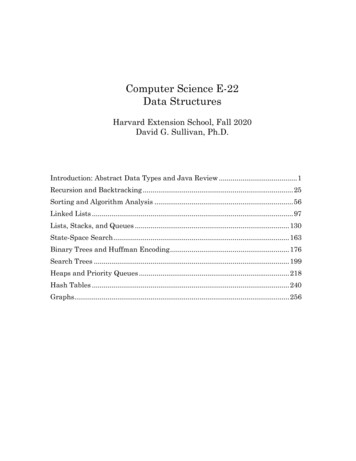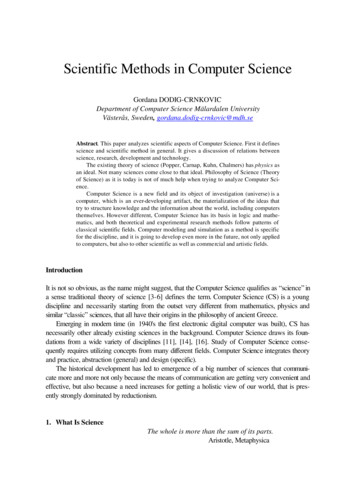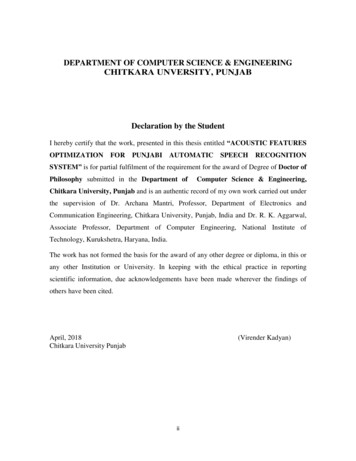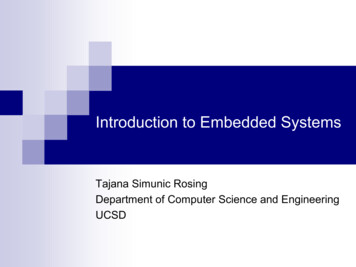
Transcription
Computer Science E-22Data StructuresHarvard Extension School, Fall 2020David G. Sullivan, Ph.D.Introduction: Abstract Data Types and Java Review . 1Recursion and Backtracking . 25Sorting and Algorithm Analysis . 56Linked Lists . 97Lists, Stacks, and Queues . 130State-Space Search . 163Binary Trees and Huffman Encoding . 176Search Trees . 199Heaps and Priority Queues . 218Hash Tables . 240Graphs. 256
Introduction: Abstract Data Typesand Java ReviewComputer Science E-22Harvard Extension SchoolDavid G. Sullivan, Ph.D.Welcome to Computer Science E-22! We will study fundamental data structures. ways of imposing order on a collection of information sequences: lists, stacks, and queues trees hash tables graphs We will also: study algorithms related to these data structures learn how to compare data structures & algorithms Goals: learn to think more intelligently about programming problems acquire a set of useful tools and techniquesComputer Science E-22Fall 20201
Sample Problem I: Finding Shortest Paths Given a set of routes between pairs of cities, determine theshortest path from city A to city RCESTER4442BOSTON49PROVIDENCENEW YORK185Sample Problem II: A Data "Dictionary" Given a large collection of data, how can we arrange itso that we can efficiently: add a new item search for an existing item Some data structures provide better performance than othersfor this application. More generally, we’ll learn how to characterize the efficiencyof different data structures and their associated algorithms.Computer Science E-22Fall 20202
Prerequisites A good working knowledge of Java comfortable with object-oriented programming concepts comfortable with arrays some prior exposure to recursion would be helpful if your skills are weak or rusty, you may want to considerfirst taking CSCI E-10b Reasonable comfort level with mathematical reasoning mostly simple algebra, but need to understandthe basics of logarithms (we’ll review this) will do some simple proofsRequirements Lectures and weekly sections sections: start next week; times and locations TBA all on Zoom, one will be recorded Five problem sets plan on 10-20 hours per week! code in Java must be your own work see syllabus or website for the collaboration policy grad-credit students will do extra problems Midterm exam Final examComputer Science E-22Fall 20203
Additional Administrivia Instructor: Dave Sullivan TAs: Alex Breen, Cody Doucette, Libby James, Eli Saracino Office hours and contact info. will be available on the Web:http://sites.fas.harvard.edu/ cscie22 For questions on content, homework, etc.: use Piazza send e-mail to cscie22@fas.harvard.eduReview: What is an Object? An object groups together: one or more data values (the object's fields – also known asinstance variables) a set of operations that the object can perform(the object's methods) In Java, we use a class to define a new type of object. serves as a "blueprint" for objects of that type simple example:public class Rectangle {// fieldsprivate int width;private int height;// methodspublic int area() {return this.width * this.height;} Computer Science E-22Fall 20204
Class vs. Object The Rectangle class is a blueprint:public class Rectangle {// fieldsprivate int width;private int height;// methods.} Rectangle objects are built according to that blueprint:width 40width 10height 12width 55height 13height 72(You can also think of the methods as being inside the object,but we won’t show them in our diagrams.)Creating and Using an Object We create an object by using the new operator anda special method known as a constructor:Rectangle r1 new Rectangle(10, 30); Once an object is created, we can call one of its methodsby using dot notation:int a1 r1.area(); The object on which the method is invoked is known asthe called object or the current object.Computer Science E-22Fall 20205
Two Types of Methods Methods that belong to an object are referred to asinstance methods or non-static methods. they are invoked on an objectint a1 r1.area(); they have access to the fields of the called object Static methods do not belong to an object – they belongto the class as a whole. they have the keyword static in their header:public static int max(int num1, int num2) { they do not have access to the fields of the class outside the class, they are invoked using the class name:int result Math.max(5, 10);Abstract Data Types An abstract data type (ADT) is a model of a data structurethat specifies: the characteristics of the collection of data the operations that can be performed on the collection It’s abstract because it doesn’t specify how the ADT will beimplemented. does not commit to any low-level details A given ADT can have multiple implementations.Computer Science E-22Fall 20206
A Simple ADT: A Bag A bag is just a container for a group of data items. analogy: a bag of candy The positions of the data items don’t matter (unlike a list). {3, 2, 10, 6} is equivalent to {2, 3, 6, 10} The items do not need to be unique (unlike a set). {7, 2, 10, 7, 5} isn’t a set, but it is a bagA Simple ADT: A Bag (cont.) The operations we want a Bag to support: add(item): add item to the Bag remove(item): remove one occurrence of item (if any)from the Bag contains(item): check if item is in the Bag numItems(): get the number of items in the Bag grab(): get an item at random, without removing it reflects the fact that the items don’t have a position(and thus we can’t say "get the 5th item in the Bag") toArray(): get an array containing the current contentsof the bag We want the bag to be able to store objects of any type.Computer Science E-22Fall 20207
Specifying an ADT Using an Interface In Java, we can use an interface to specify an ADT:public interface Bag {boolean add(Object item);boolean remove(Object item);boolean contains(Object item);int numItems();Object grab();Object[] toArray();} An interface specifies a set of methods. includes only the method headers does not typically include the full method definitions Like a class, it must go in a file with an appropriate name. in this case: Bag.javaImplementing an ADT Using a Class To implement an ADT, we define a class:public class ArrayBag implements Bag {private Object[] items;private int numItems; public boolean add(Object item) { } When a class header includes an implements clause,the class must define all of the methods in the interface. if the class doesn't define them, it won't compileComputer Science E-22Fall 20208
Encapsulation Our implementation provides proper encapsulation. a key principle of object-oriented programming We prevent direct access to the internals of an objectby making its fields private.public class ArrayBag implements Bag {private Object[] items;private int numItems; We provide limited indirect access through methodsthat are labeled public.public boolean add(Object item) { All Interface Methods Are Public Methods specified in an interface must be public,so we don't use the keyword public in the definition:public interface Bag {boolean add(Object item);boolean remove(Object item);boolean contains(Object item);int numItems();Object grab();Object[] toArray();} However, when we actually implement the methodsin a class, we do need to use public:public class ArrayBag implements Bag { public boolean add(Object item) { Computer Science E-22Fall 20209
Inheritance We can define a class that explicitly extends another class:public class Animal {private String name; public String getName() {return this.name;} }public class Dog extends Animal { We say that Dog is a subclass of Animal, and Animal is asuperclass of Dog. A class inherits the instance variables and methodsof the class that it extends.The Object Class If a class does not explicitly extend another class, it implicitlyextends Java’s Object class. The Object class includes methods that all classes mustpossess. For example: toString(): returns a string representation of the object equals(): is this object equal to another object? The process of extending classes forms a hierarchy of classes,with the Object class at the top of the hierarchy:ObjectArrayBagComputer Science E-22StringAnimalAntCatFall 2020Dog10
Polymorphism An object can be used wherever an object of one of itssuperclasses is called for. For example:Animal a new Dog();Animal[] zoo new Animal[100];zoo[0] new Ant();zoo[1] new Cat(); The name for this capability is polymorphism. from the Greek for "many forms" the same code can be used with objects of different typesStoring Items in an ArrayBag We store the items in an array of type Object.public class ArrayBag implements Bag {private Object[] items;private int numItems; } This allows us to store any type of object in the items array,thanks to the power of polymorphism:ArrayBag bag new ArrayBag();bag.add("hello");bag.add(new Double(3.1416));Computer Science E-22Fall 202011
Another Example of Polymorphism An interface name can be used as the type of a variable.Bag b; Variables that have an interface type can hold references toobjects of any class that implements the interface.Bag b new ArrayBag(); Using a variable that has the interface as its type allows usto write code that works with any implementation of an ADT.public void processBag(Bag b) {for (int i 0; i b.numItems(); i ) { } the param can be an instance of any Bag implementation we must use method calls to access the object's internals,because we can't know for certain what the field names areMemory Management: Looking Under the Hood To understand how data structures are implemented,you need to understand how memory is managed. There are three main types of memory allocation in Java. They correspond to three different regions of memory.Computer Science E-22Fall 202012
Memory Management, Type I: Static Storage Static storage is used for class variables, which are declaredoutside any method using the keyword static:public class MyMethods {public static int numCompares;public static final double PI 3.14159; There is only one copy of each class variable. shared by all objects of the class Java's version of a global variable The Java runtime allocates memory for class variableswhen the class is first encountered. this memory stays fixed for the duration of the programMemory Management, Type II: Stack Storage Method parameters and local variables are stored in a regionof memory known as the stack. For each method call, a new stack frame is added to the topof the stack.public class Foo {public static int x(int i) {int j i - 2;if (i 6) {return i;}return x(i j);}public static voidmain(String[] args) {System.out.println(x(5));}}j6i8x(8)return addrj3i5x(5)return addrargs When a method completes, its stack frame is removed.Computer Science E-22Fall 202013
Memory Management, Type III: Heap Storage Objects (including arrays) are stored in a region of memoryknown as the heap. Memory on the heap is allocated using the new operator:int[] values new int[3];ArrayBag b new ArrayBag(); new returns the memory address of the start of the object. This memory address – which is referred to as a reference –is stored in the variable that represents the object:values 0x23a0x23a000 We will often use an arrow to represent a reference:values000Heap Storage (cont.) An object remains on the heap until there are no remainingreferences to it. Unused objects are automatically reclaimed by a processknown as garbage collection. makes their memory available for other objectsComputer Science E-22Fall 202014
Two Constructors for the ArrayBag Classpublic class ArrayBag implements Bag {private Object[] items;private int numItems;public static final int DEFAULT MAX SIZE 50;public ArrayBag() {this.items new Object[DEFAULT MAX SIZE];this.numItems 0;}public ArrayBag(int maxSize) {.} A class can have multiple constructors. the parameters must differ in some way The first one is useful for small bags. creates an array with room for 50 items. The second one allows the client to specify the max # of items.Two Constructors for the ArrayBag Classpublic class ArrayBag implements Bag {private Object[] items;private int numItems;public static final int DEFAULT MAX SIZE 50;public ArrayBag() {this.items new Object[DEFAULT MAX SIZE];this.numItems 0;}public ArrayBag(int maxSize) {if (maxSize 0) {throw new IllegalArgumentException("maxSize must be 0");}this.items new Object[maxSize];this.numItems 0;}.} If the user inputs an invalid maxSize, we throw an exception.Computer Science E-22Fall 202015
Example: Creating Two ArrayBag Objects// clientpublic static void main(String[] args) {ArrayBag b1 new ArrayBag(2);ArrayBag b2 new ArrayBag(4); // constructor}public ArrayBag(int maxSize) {. // error-checkingthis.items new Object[maxSize];this.numItems 0;stackheap}// returnsb2b1args itemsnumItemsnull null0Example: Creating Two Arr
a special method known as a constructor: Rectangle r1 new Rectangle(10, 30); Once an object is created, we can call one of its methods by using dot notation: int a1 r1.area(); The object on which the method is invoked is known as the called object or the current object. Computer Science E-22 Fall 2020 5. Two Types of Methods Methods that belong to an object are referred to as .











